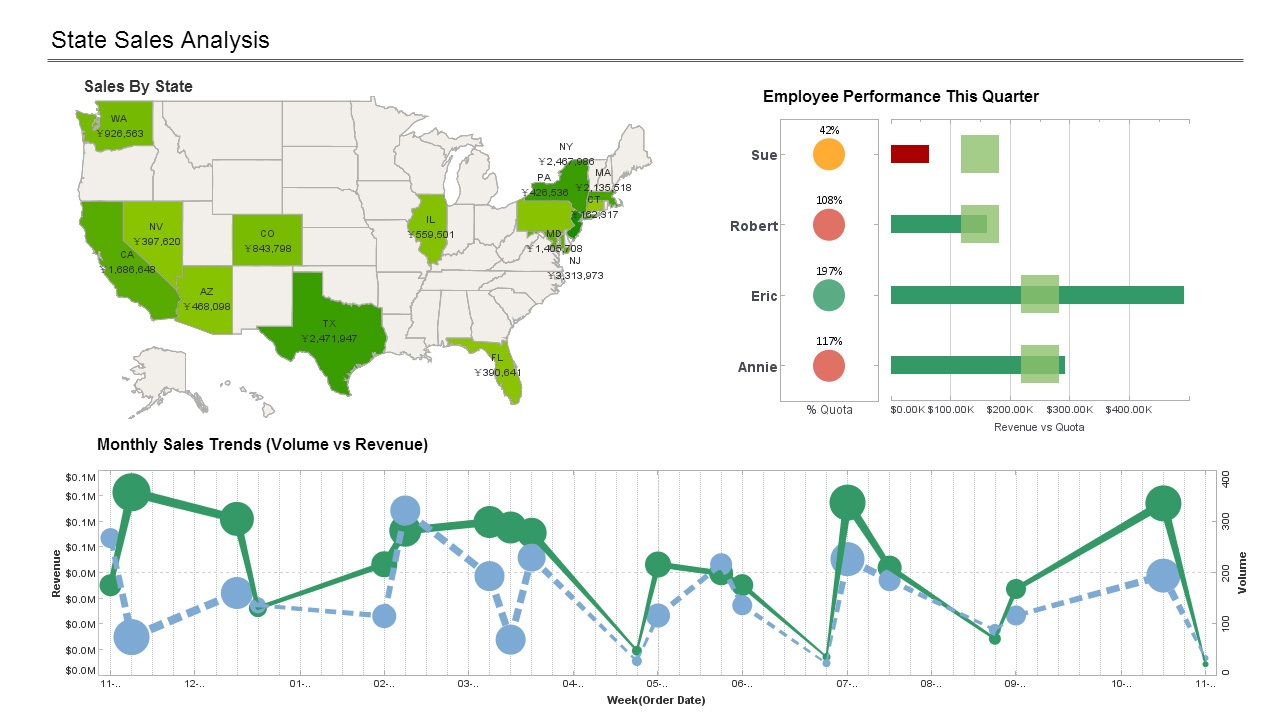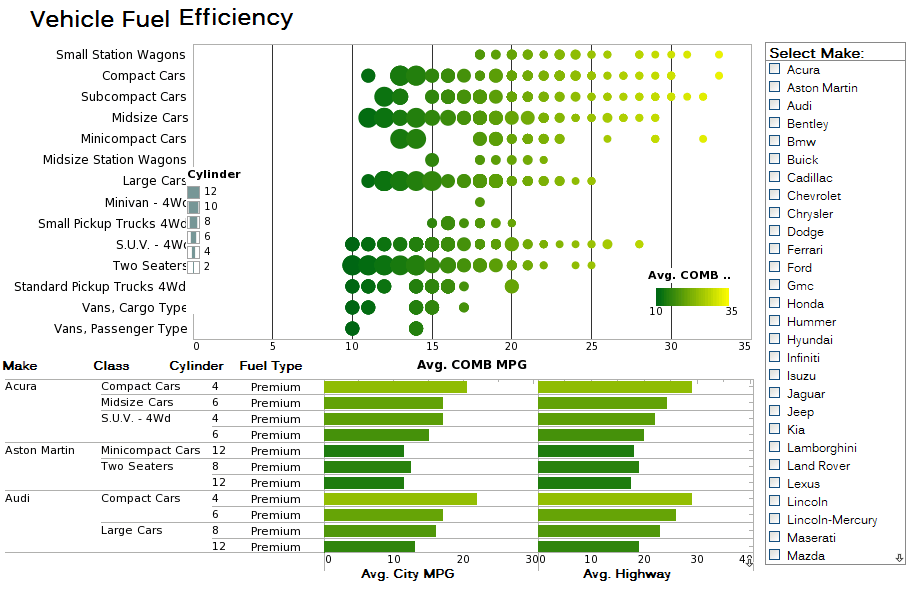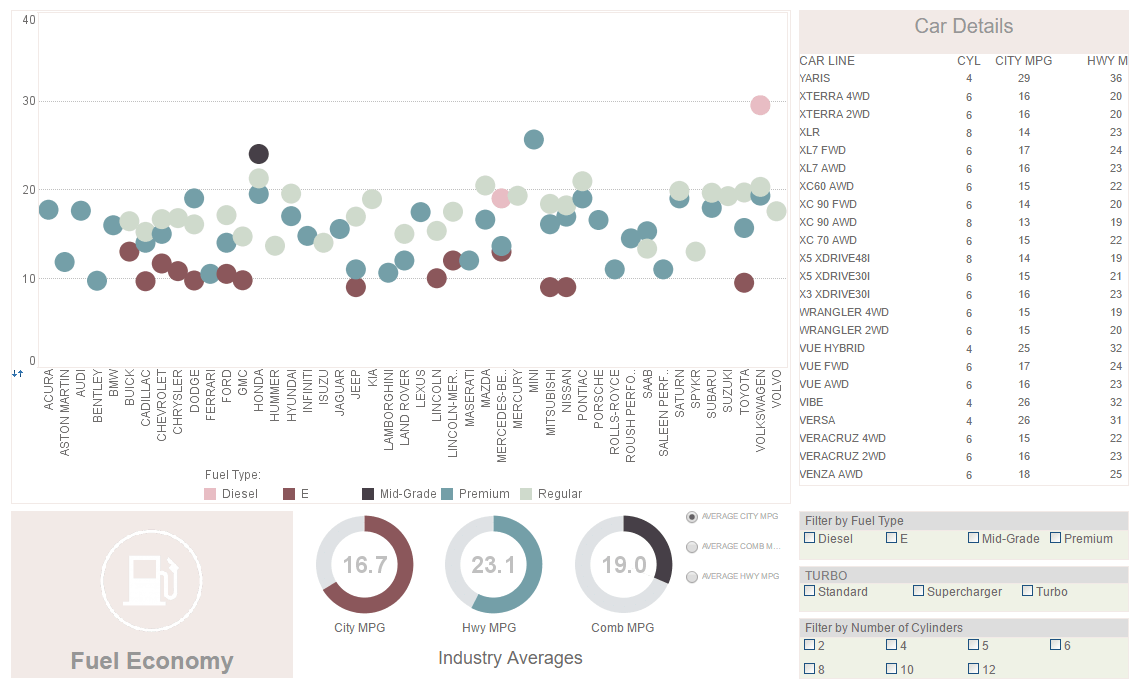About InetSoft's Enterprise Data Management Application
Looking for an enterprise data management application that also includes dashboards and reporting? InetSoft offers Web-based BI software that includes a flexible data access engine. No need for a data warehouse with direct access to disparate operational data sources of almost any type. Below are articles about InetSoft's software:
Structured and Free-form Queries - Queries are written for specific data access purposes and contain logic beyond the generic data model. Queries typically utilize advanced or proprietary database features. The idea is similar to relational database views, except that queries are normally not generic enough to be created as permanent database objects or views. In the Data Modeler, queries can be quite flexible, depending on the query parameters and data selection. For non-relational data sources, queries are often the only available means to obtain the required dataset. In this situation, generic queries can serve the purpose of database views. For relational data sources, stored procedures and other query derivatives are treated as queries. Just like data model objects, queries are atomic data blocks that cannot be changed by end users. However, they can be transformed and combined with data model objects, for use in more sophisticated applications...

Taking the Pragmatic Approach to Big Data Analytics - This webinar is inspired by a series of reports a research group put out. The most recent was called “Analytics: The Real-World Use of Big Data.” Last year, they published a study called Analytics: The New Path to Value. And in that study they took a high level look at the market and where organizations were placed along that maturity sophistication curve. They followed that up with a study called Analytics: The Widening Divide, and in that study they took a look at those sophistication levels and where organizations were focusing and took it a level down into the organizations themselves and how they were organizing themselves and executing an analytics within their organization. This year came Analytics: The Real-World Use of Big Data. So that’s a subset of the overall analytics market focused on the Big Data topic. Some of the questions, not all of them, but some of them, carry through from year to year. But they really try to touch on what’s most timely for executives in the business market place around the globe to focus on...
Talking to the Business about Data Management - How do you talk to the business about data management? I think we already lose the business when we mention words like reference data entities, CDI, and PIM. We’re going to start to get blank stares from the business folks. You have got to tie it to the business driver. Where’s the pain that the business is feeling? Is it the fact that they are sending out bills and some of those bills aren't getting sent out because they don't have the right customer address and customer name? They are losing revenue. Or is it that they don't know who the customers are. So MDM really is an enabler of business applications, strategic objectives. Pitch it that way, but if you pitch it in technical terms probably won't get too far. You want the equity. People get to hear these buzzwords of PIM and CDI, and they don't realize well those are just words for the underlying technology that enabled a business process. It’s critical that people understand it. Do I have a problem surrounding my new product introduction that takes so long to get that to the business? That’s directly is impacting my ability to get that product to market. If that’s caused by having poor master data, poor master data process, that’s the pain point. Another big driver for MDM now is compliance, anything such as Sarbanes-Oxley, et cetera. What is my risk, my exposure within my company if I don't know what customer is tied to what specific sale? Or what is my exposure or my risk on a financial transaction, et cetera? And all that can be tied directly to be having poor master data...
Technologies and Methodologies of Big Data - Today we are talking about Big Data. It has become a very popular topic nowadays in business intelligence. There were obvious reasons why, there are all kinds of sources of data now that challenge us. It’s not just the amount of data but also the type of data that is really giving organizations a run for their money in terms of being able to leverage this information and get some value from it. So I am going to share a generic kind of formula here that you might want to consider when you are looking at Big Data. Generally speaking, working with big data sets, either because of their size or their complexity, tends to exceed the ability of the traditional BI tools or commonly used BI technologies that you may have in place for analyzing data, for managing information or for running processes. When this happens, when Big Data gets introduced to your environment, some of these traditional technologies either falter or probably become stretched a little bit beyond their normal capabilities...
Telling the Truth with Your Data - The next point is talking about telling the truth with your data. It’s called graphical integrity. As a viewer, as a consumer of data and graphical data, there’s nothing more annoying than being lied to by a report, or by a chart, or by a graph, and yet this happens all the time. There are a few different ways that people will lie with their graphs. One way is that they will misrepresent the data that they’re showing. They’ll misrepresent changes in the data. Very often they’ll use the length of a line or the size of an object to represent the relative growth of something. So, you’ll see lines getting longer and longer over time to indicate that a number gets larger and larger over time. But unless that object gets larger where the same proportion to the number gets larger, then that object is lying to you. So for example, here’s a graph that shows the mandated fuel economy for automobiles in the 1970’s. The government mandated the average fuel economy had to be 18 miles per gallon in 1978 ,and it went up every year until it was mandated to be 27.5 miles per gallon in 1985...
Ten Biggest Big Data Trends for 2017 - Hello everybody, good morning, good evening and good afternoon, depending on where in the world you're listening from. My name is Abhishek Gupta, I'm Product Manager here at InetSoft, and I am very excited to welcome you to our 10 Biggest Big Data Trends for 2017 webinar. This is part of a three-part series we are doing on data trends. A little bit housekeeping before we get started. Everyone's lines are muted, but we encourage you to use the Q&A feature to ask questions throughout the webinar. We will leave at least 10-15 minutes at the end to get through those, so please, please fire off questions as they come to mind, and we are going through them at the end of the presentation. Everyone who is registered for this will also be receiving a copy of the presentation link to the recording afterwards, so no need to take copious notes, the slides are also available on InetSoft.com as we speak, as we published this a little while ago...
Three Principal Ways to Retrieve Data - There are three principal ways to retrieve data from a datasource: Query: A query is a specific request for data from the datasource (i.e., a request for specific columns and rows), typically written in the SQL language. Style Studio provides a wizard to make query creation easy. See Query a Relational Data Source for information on how to create a query. Data Model: A data model provides an all-encompassing representation of your data, a view into your database suitable for business users. Because a data model is not a specific request for data, but rather a model of your database schema, it is much more flexible than a query. See Data Models for more information. Data Worksheet: A Data Worksheet can represent a complex query or a mash-up data from different data sources. See Create a Data Worksheet for more information. The table below highlights the advantages and disadvantages of these different approaches...
Tips for Data Visualization in Big Data - We are in a business environment in which around 3 trillion bytes of information are generated every day. This large amount of information has grown due, in part, to the Internet and the continuous technological increase in communications and data collection...
Tools to Solve Data Integration Problems - Let us talk about some other tools and methods that people use to solve data integration problems. First I would like to go to the list of terms that we hear a lot and give short definitions to help put some of them into context, but before we a three letter acronym game, how familiar are people with these terms already? I often ask my clients and people I talk to at conferences and seminars and users groups whether they have heard of these terms. The usual response is no, or maybe one or two of the terms. It is real test to keep track of all the terms since they seem to be created regularly. So let us demystify them. I am going to just go down the list and let us start with an oldie but a goodie: ETL or Extract Transform and Load. Well, actually, before we look at ETL, remember that a quick definition again of data integration is transforming data into information and delivering to the business. Note in my definition doesn’t talk about how it happens, just what it is...
Traditional Data Management and Business Intelligence Companies - What does this shift towards big data solutions mean for traditional data management and business intelligence companies? Fairly obviously when you talk about anything new like big data, the question is, is this going to replace traditional data management tools, and the answer is gosh, no. This is true for two good reasons. First of all, there is still a lot of information in most corporations’ databases on which they are still not properly reporting and extracting all the insights and analysis from. That is going to continue to be a source of growth and revenue for decades to come. Next, not all databases need the big data tools. Those are new kinds of tools, and there are things that they do well. But there are other things they do less well. The traditional database tools are well integrated and easy to use and well understood. So those are going to hang around for that reason, as well. I think the other thing, though, is you need to use big data tools when other tools don’t work. It’s the thing you use when the stuff you already have isn’t capable of extracting the insight...
Trend of Big Data Analytics - Hey, let’s bring in our good friend Philip Russom from TDWI. Welcome back to DM Radio. Philip Russom: Hey, Eric. Eric Kavanagh: So you have this great concept, I know, I have done some webcasts with you on it, and we have talked about it on DM Radio before, but you track mega trends, which are these big broad trends that impact all sorts of different bits and pieces of the market place. And one of them has to do with data integration, right? Do you want to talk about that? Philip Russom: Yeah, you know, actually the mega trends are really broad, and they tend to influence everything, not just data integration, but databases, applications, just presently hit everything in IT. And for years one of the leading mega trends, at least one that was the most pressing issue, and for some organizations it was actually a crisis level, that would be the increase of data volumes. And if you think back to when the first explosions of data volumes hit us in the late 90s, early 2000s, you know a lot of organizations weren’t prepared for that, and a lot of the technology for managing data wasn’t there...
Types of Multidimensional Data? - Data with several dimensions or properties is referred to as multidimensional data. To comprehend complicated systems and events better, it is often utilized in data analysis, machine learning, and data visualization. We shall talk about numerous multidimensional data types and their uses in various domains in this post. Multidimensional Data Types and Categories Space Data Data with a geographic or geographical component is referred to as spatial data. It may include details on the position, size, and dimensions of objects, as well as the separation and direction between them. Satellite photography, topography maps, and GPS coordinates are a few examples of spatial data...
Understanding MDM - Definition and Basics - There’s a lot of talk about master data management, otherwise known as MDM, these days. But MDM can be defined very differently at different organizations, we’ve learned. In fact, experts tell us there are three distinct styles of MDM which require different approaches, different tools, and different best practices. So, today we’re learning more about these three styles of MDM, often referred to as operational, analytical and enterprise MDM. Let’s start with a level set by sharing a basic definition of master data management, ideally also using basic terms that are easy for CEOs or high level management to understand. Well, of course that’s always a little bit more difficult, but let me give you a couple different definitions. If I’m talking to a business person, I’m probably not even going to use the word MDM, at least certainly not in the first 30 seconds, and it also going to depend on what industry that executive or business person is in. If the person is in retail or financial services, I’m going to talk to the person about customer data integration because that’s their pain point. That’s what they see is their issue with data...
Unstructured Big Data - Big data refers to large volumes of data that are too large or complex to be processed and analyzed using traditional data processing tools. The emergence of big data as a recognized area of study arrived in the context of massive data sets provided by online social activities such as those facilitated by Facebook and Twitter and other social media, but was recognized to also describe the data challenges faced in many other disciplines, such as finance, climate analysis, genomics, communications, and so on. Structured data is data that is organized in a specific format, such as a table in a database or a spreadsheet. It is typically easy to process and analyze because it is organized in a way that is easy for computers to understand. Unstructured data, on the other hand, does not have a predetermined format and may include text, images, audio, and video. It is often more difficult to process and analyze because it does not fit neatly into a structured format...
Using Big Data Analytics in the Biotech Industry - The power of data in contemporary business and science is immense. No industry can really make progress without the analysis of massive information libraries that give us fresh insights and enable new breakthroughs. Biotech is not an exception here as it relies heavily on big data analytics. But how does data science influence the biotech industry? What are the most common use cases of big data in biotechnology? If you are interested in seeing the answers, keep reading to learn more about this amazing topic...
Vanity Metric KPIs - There's a saying that your vanity metrics should be "all things to all people." This is true, but only up to a point. Sure, it's great to have analytics that everyone can use and are "user-friendly," but you also need to ensure they're metrics that can impact the business. Suppose you can't figure out which KPIs are most likely vanity metrics. In that case, it's time to stop doing them and start focusing on things like revenues and net new clients. These two will get your business more sales leads and clients better than any other existing metric. What Are Vanity Metrics? Vanity metrics are a type of metric that are not directly related to the core business. For instance, some companies track the number of likes on their Facebook page or the number of followers on Twitter. These metrics may be important to the company, but they don't really help them grow their business. The term "vanity metric" was coined by marketing expert Seth Godin in his book Linchpin: Are You Indispensable? The term is used because it sounds like something that's important only to you and not your customers...
Varying Levels of Complexity in using Data Visualization - Eric Kavanagh: Yeah. That actually brings up a good question I’ll throw over to Mark and then maybe to Dale for some closing comments here. Mark, do you have or do you offer different levels of complexity?...
Viewing the SQL Query Plan of a Table - To view the SQL statements that a table will attempt to execute (the query plan), right-click the title bar, and select ‘Show Plan’ from the context menu. This opens the ‘Query Plan’ dialog box. The ‘Query Plan’ dialog box displays the queries that will be sent to the database at runtime. Additionally, it shows the data operations that the Worksheet will perform in post-processing, after the data is retrieved from the database. By default, the Worksheet attempts to create a single SQL query that fully generates the table’s data. This is typically the most efficient approach because it allows the database to perform all the needed data operations (joins, filtering, etc.). However, you can override this behavior for a particular table by deselecting the ‘Merge SQL’ option in the ‘Table Properties’ dialog box...
Virtual Data Warehouse Approach - Our next guest. Segue right into Rich Walker from Denodo Technologies. Hey, welcome back to DM Radio. Rich Walker: Thanks, I appreciate it. Eric Kavanagh: Oh, you got a little bit of buzz on your line there, probably go back to your headset, and tell you what, we will bring in Ian Pestel in the meantime, hopefully, he is ready. Ian, welcome to DM Radio from way across the pond, right? Ian Pestel: Yes, that’s right. Yes, good afternoon, and thanks for having me on the show. Eric Kavanagh: Sure. I think you are a little bit softer, probably just because you are a thousands mile away or more. I guess it's further than that. Ian Pestel: Okay, I will try to speak louder. Eric Kavanagh: Sure, thanks. So let’s talk about, well, you guys talk about data virtualization. That’s certainly a way to avoid some bottlenecks is to identify certain data sets or data feeds where either they are not that critical or they don’t have to go through the traditional process, the batch ETL process, in order to get where they need to go. But I am guessing that’s something that you often recommend to customers right...
Virtualized Data Warehousing - And that’s where you need to think through your metadata and semantic abstraction layers. What do you rollout that can unify at least there is a metadata for structured, semi-structured, unstructured information so you can, for example, access data not just at the records level, but also if it happens to be text, and if the sources are text, how can you access it through semantic approaches that allow you to determine the concepts and taxonomies and do searches and manipulation of information using that sort of metadata? So in order to start, you need to think through the semantic abstraction and the approaches that help you to bring this all together. And really in terms of normalizing it and reusing it in a broad range of applications like BI, you start to need to think through the policies and rules governing how this information in various formats, implementing various schemas can be, what policies and rules are relevant to orchestration of the integrations and the transformations and the calculations and so forth...





